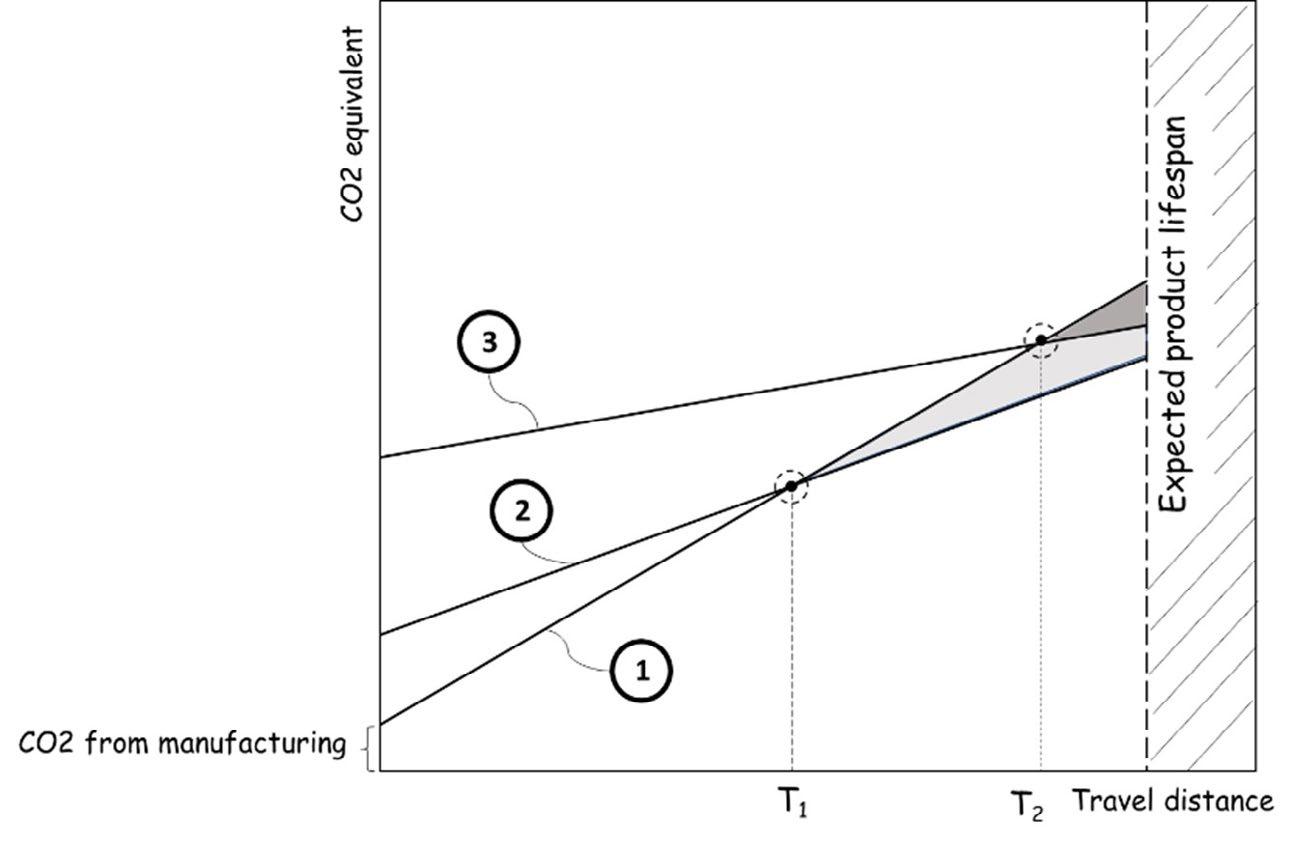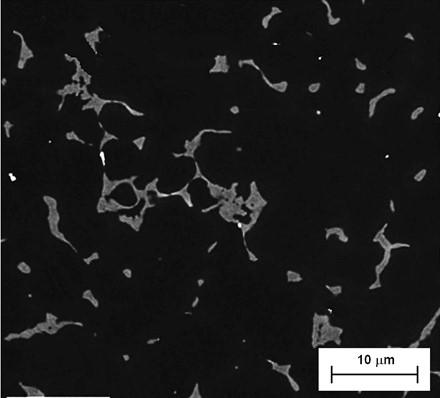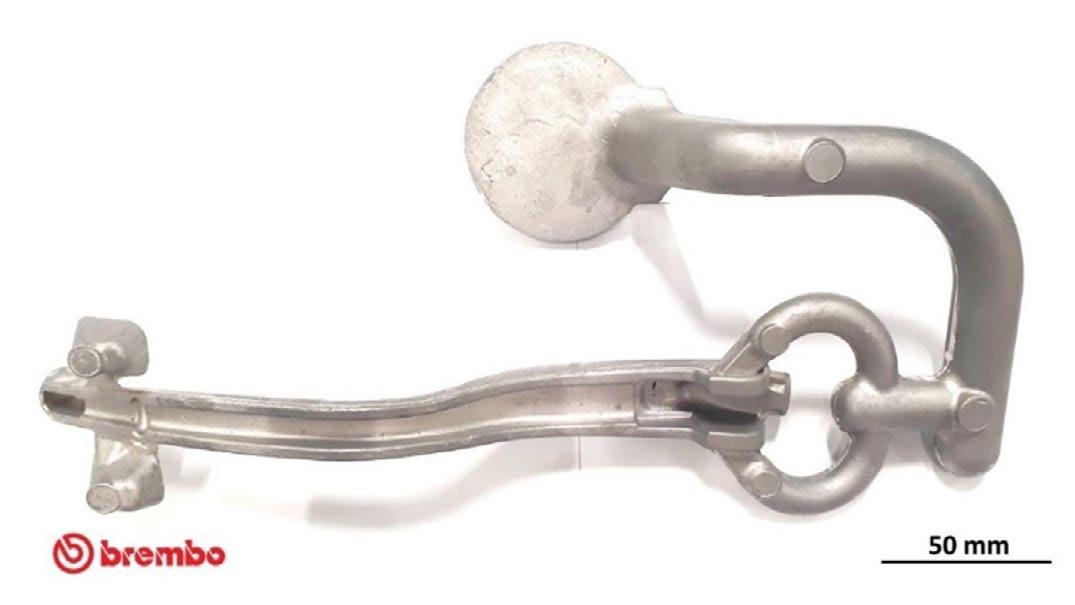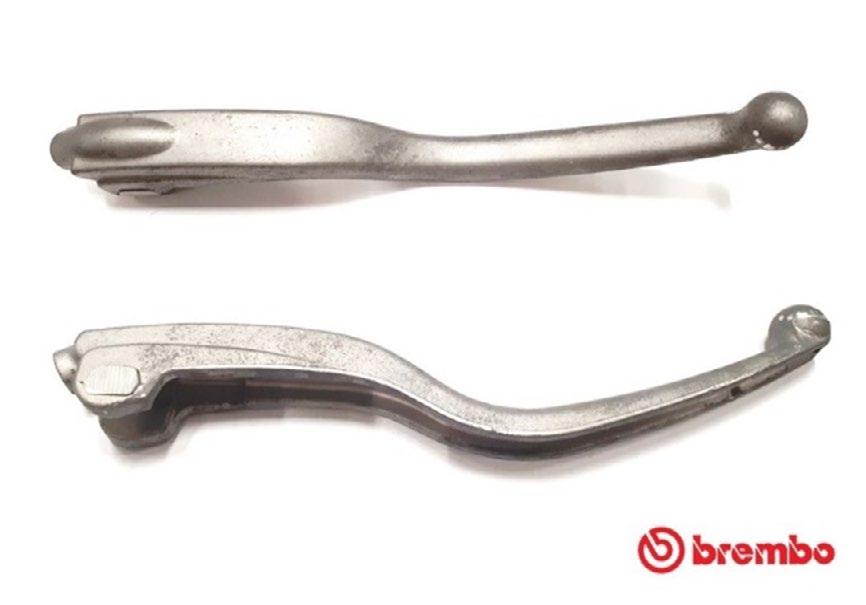
14 minute read
F. D’Errico, A. Gruttadauria, G. Perricone, D. Casari, M. Romeo.......................................................... pag
Eco-sustainable lightweight automotive part manufacturing: GHGs-free die casting of brake leverage prototype made of AZ91D-1.5CaO magnesium alloy
F. D’Errico, D. Casari
Employing non-flammable AZ91D-1.5CaO Eco-Magnesium® (Eco-Mg) alloy in the European project CRAL provides the lowest carbon footprint for the magnesium cast process. Non-flammable magnesium AZ91D alloyed with Ca (in the form of CaO) was successfully processed by experimenting specific casting process window to melt the non-flammable magnesium alloy in a stationary furnace with no SF6 cover gas and then poured in the air into a vertical shortinjection displacement press machinery specifically developed in EU CRAL project. Brake leverage made of AZ91-1.5CaO Eco-Mg series alloy was successfully manufactured at Brembo Spa premise, as a real example of Mg cast component alternative to the current component made of forged aluminium alloy. As discussed in the experimental part, a preliminary computer-aided simulation test campaign reduced uncertainty in cast trials. The CRAL EU project with the realization of Mg-SF6 free cast part for brake systems has promoted the drastic reduction of Global Warming Potential (GWP) of the Mg cast process route. The Eco-Mg series is a feasible and affordable casting solution for introducing non-flammable Mg alloys in the automobile sector; today struggled for researching cost-driven lightweight components due to forthcoming CO2 emissions restrictions.
KEYWORDS:MAGNESIUM, CALCIUM OXIDE, SUSTAINABLE METALLURGY;
INTRODUCTION Led in the last century by the aerospace industry, the development of magnesium alloys has historically occurred to meet the needs of the transport industry, which sought to find advantages on additional strategies related to weight reduction. Compared to aluminum alloys, magnesium has a high castability and reduced chemical compatibility with the steel used in constructing the molds. This property makes it possible to realize part geometry at very high complexity (similar to those realized with plastics), extending steel molds' lifespan. Although these are great promising features, safety is still a concern due to high flammability when magnesium is treated in the air. Once ignited, magnesium proceeds with its self-combustion sustained by an exothermic reaction forming magnesium oxide, releasing heat. As a result, the combustion flame rapidly reaches temperatures between 2,000 ° K and 4,000 ° K. For this problem, magnesium F. D’Errico
Politecnico di Milano, Department of Mechanical Engineering, Milan, Italy
D. Casari
Brembo Braking Systems, Stezzano, Italy
alloys require unique melting plants and expert personnel, increasing the production cost of cast parts. To safely control Mg alloys in the molten state, it is necessary to eliminate the presence of O2 in contact with the metal bath; that is to say, it is necessary to eliminate the primary trigger source of the Mg combustion reaction. Removing oxygen is possible by creating inert atmospheres towards the molten Mg. Various techniques are used in Mg foundries divided into a) vacuum melting plants, b) melting plants equipped with inert and protective atmospheres of the Mg bath. The inert atmospheres usually used are mixed SF6 and CO2, based on freon gas R-134a and SO2. Both SF6 and freon gas R-134a are greenhouse gases with very high global warming potential (GWP). In contrast, SO2 gas, despite being a valid alternative to greenhouse gases SF6 and R-134a from an environmental point of view, requires stringent application protocols due to its high toxicity for operators. The SO2 gas would be a green solution against SF6, but it is highly corrosive to the equipment made of steel; it reacts readily with water to form H2SO3, thus provoking health risks for workers, especially for the skin and lungs. Compared with SO2, SF6 is non-toxic, non-corrosive, but due to the negative impact on the greenhouse effect, by 1 January 2018 in the European Union, SF6 has been prohibited in magnesium die-casting in the recycling of magnesium die-casting alloys [1]. Today it is common knowledge that the choice of lighter materials for manufacturing combustion engine-powered vehicles plays a crucial role in reducing emissions. For automakers, the weight saving is not only a key strategy to be compliant with a green-consciousness market pushed by demand more and more aware of the environmental and social impact that comes with eco-responsible purchases. The new stringent targets set in the EU for the feet-wide average emissions of new cars and vans include, together with penalty payments for excess emissions, a mechanism to incentivize the uptake of zero- and low-emission vehicles. However, cleaning up vehicle emissions at the tailpipe is an effective but partial measure if we refer to an enlarged green-manufacturing view.
Fig.1 - Three qualitative scenarios for addressing at-a-whole the environmental impact over the product lifespan of using light metals (2) and (3) to substitute the heavy solution (1).
If we point out the linear function emissions over travel distance as it is depicted in Fig.1, we can just consider two scenarios: the baseline scenario of part made of heavy ferrous alloy (1), and two different lightweight solutions, capable of answering the same functional property of the steel-made part. Depending on the "slope" and the initial carbon footprint "stored" in early alloy manufacturing and part shaping, even though the direct CO2 emissions are lowered (look at the slope of (1) and (2) solutions), the break-even point could be reached after long-distance traveled. The problem depicted by (3) in Figure 1 is typical of magnesium alloy fabricated starting from primary magnesium ingots obtained by small—scale Pidgeon processes based on thermal reduction of magnesium-be-
aring ores (like dolomite) with silicon (usually supplied in from of ferrosilicon) conducted in coal-fired retorts [2]. Furthermore, due to its high reactivity, magnesium needs to be cast for product shaping using protective gases. In the past, SF6, the preferred cover gas, was replaced by mixtures of CO2 and SO2 by HFC-134a. Recently the Novec 612 fluid registered by the 3M Company promises a very low GWP of 1, equivalent to CO2. Several studies have shown that magnesium auto part produced by raw material fabricated by Pidgeon process and secondly shaped by casting using pollutant cover gases could not save CO2 within the car's lifespan [3]. The high Mg reactivity with oxygen is the low density of the magnesium oxide layer formed during melting in the presence of oxygen. Although various metals form a thick, dense, and non-porous oxide layer, this does not apply to magnesium [5-9]. The volume change between molten metal and the oxide layer formed on the top surface is responsible for surface stresses (Fig.2).
Fig.2 - The PBR explanation of the high temperature oxidation behavior of different metals and their oxides in correlation with porous or non-porous oxide film developed by air oxidation.
The Pilling-Bedworth (PBR) ratio between the molar volume of oxide concerning the molar volume of metal is an indicator to evaluate either tensile or compressive stresses developed in the oxide layer [5]. For PBR < 1, tensile stresses form and cause the oxide layer cracking. Emley [6] found that up to 450 °C, magnesium forms a protective layer, but above 450°C, it becomes porous and non-protective. The time to ignition depends on the magnesium alloy composition [8,9]. The protective gases used in the magnesium industry form a dense protective layer on Mg melt. A recent approach is to add unique alloying elements to improve the ignition resistance. Additions of small amounts of Be, Al, and Ca [6] enhanced the oxidation resistance of solid Mg alloy near the melting point and that the alloy could be melted in the air if the oxide skin on the ingot was not broken. Sakamoto et al. [10] verified that the oxide film on the Mg–Ca consists of CaO surface thin layer, and just below this layer, a mixture of MgO–CaO exists below this layer. To date, the main reason for this protective effect from Ca-O is not clarified. One prominent hypothesis embraces the PBR rule, the higher thermodynamic stability of Ca-O added oxide layer and the kinetics of the diffusion and reaction of Mg ion at and trough the oxide layer formed by the mixture of MgO and CaO the large volume of CaO might compensate for the shrinkage due to MgO formation [11]. Consequently, the compositions of the Mg alloys can be used to improve the ignition and oxidation resistance of Mg alloys. Among possibilities, the ECO-Mg (Environment COnscious magnesium) alloy system based on CaO addition is available on the market [12]. Following the urgent need to find new eco-compatible solutions to process Mg with a drastic reduction of the carbon footprint, reduction of total GHGs emitted over product cycle of Mg cast parts would be challenged by

elimination of protective gases during the cast part manufacturing (protective gases is still used for master alloy production).
EXPERIMENTAL PROCEDURE A commercial Eco-Mg series alloy AZ91D with a nominal composition of 8.5% Al, 0.75% Zn, 0.3% Mn, Fe and Ni below 0.001%, and Mg as a balance modified with 1.5%CaO provided by Korea Institute of Industrial Technology was employed as experimental material. The ascast microstructure when supplied in ingot and it shows usual microstructure of high aluminum content casting magne-sium alloy with coarse structure of α-Mg and the network of eutectic β-Mg17Al12 compound discon-tinuously distributed at the grain boundaries (fig. 3).
Fig.3 - SEM image of as-cast billet received.
A vertical injection die-casting press machinery in the Advanced Materials Research and Develop-ment laboratories in Brembo facility in Stezzano has been employed for casting the eco-magnesium metal alloy. The machinery is a scale-down replica of the industrial press machinery developed and installed in Brembo foundry during the European CRAL Life project terminated in December 2019.

Tab.1 - Main machine press and cast part dimensioning data.
In table 1 are gathered main machine dimensioning data. The adoption of vertical lay-out was based on main objective of reducing as possible injection plunger stroke in order to target several benefits, such as: • reducing duration of the injection phase, thus decreasing total cycle time of the process with semisolid metal handling; • reducing the displacement velocity of plunger during injection in order to reduce turbulence; the maximum injection velocity set in the press machine is 135mm/s, actually around 1 order of magnitude lower than conventional horizontal high pressure die casting machine; • (thanks to the bottom-up vertical injection layout) reducing total quantity of air to evacuate during injection; this implies it is possible to reduce the maximum injection pressure required for air elimination, resulting in compact size of the machine and consequently low equipment cost.
Machine characteristics
Injection plunger velocity (two velocity stages available over plunger total stroke) Plunger total stroke Theoretical locking force Projected complete shot area Specific pressure on metal (max) Injection force
0,28 (+10%) m/sec
100 mm
700 (+15%) kN
135 cm²
533 kg/cm²
200 (+15%) kN
RESULTS AND DISCUSSION An AZ91D commercial alloy with the addition of 1.5%CaO compound was tested, avoiding uses of SF6 since it has been banned for die-casting process in Brembo foundry. To that scope, the commercial Eco-Mg AZ91D-1.5CaO has been employed to retard oxidation of magnesium in a molten state with the high risk of burning reaction to start and ignite not self-extinguishable flame. As the ignition of conventional Mg alloys occurs because of porous MgO surface oxide film at high temperature, CaO added in Mg is thought to solidify with reactive phase formation Mg2Ca, regard-less of CaO contents and process condition [13]. Expressly, during oxidation under an ambient at-mosphere, the Mg2Ca phase on the surface might dissociate by oxygen to form on the molten metal layer directly exposed to air because of porous MgO [13]. This way, a thick, continuous, and protec-tive oxide film consisting of CaO and MgO forms isolating metal baths from the atmosphere. It is reported by Kim et al. l. [13] the 1.5 mass %CaO added AZ91 Mg increased at 615°C, thus about 300°C compared to conventional AZ91D alloy. Due to the low quantity of magnesium to cast in press machine and its poor heat capacity (substance with a low heat capacity, will heat and cool quickly), to avoid incomplete filling of such a complex cavity, it was necessary to increase the melting temperature in the stationary furnace up to 700°C. That allowed to maintain the final pouring temperature above 630°C when poured in the pre-heated injection chamber within the range 220-250°C. Therefore, the alloy was overheated in a closed fur-nace in air, but for over 10 minutes, it exhibited early ignition problems, safely controlled by using protective flux with CaF powders. Therefore, the other test campaign was devoted to reducing the stationary furnace's oxygen content to eliminate the use of any type of fluxes to protect the molten bath from oxidation. The ultimate solution was found by mounting a cap that covered the furnace by a hermetic seal for insufflation of a small quantity of nitrogen; insufflation of nitrogen limited the oxygen content inside the furnace and created slight internal overpressure to avoid fresh oxygen to be introduced from outside. Due to the revised stationary furnace equipment, the molten magnesium alloy was safely maintained in overheating conditions for a prolonged time (up to 1 hour during casting tests). No ignition prob-lems occurred during a few minutes (not more than 2 minutes) of fresh air exposure of the overheated magnesium necessary for the following steps: a) dosing the proper volume of metal by the use of a second pre-heated dosing refractory crucible, b) final pouring of proper magnesium alloy volume into the hot injection chamber.

( a) ( b)

Fig.4 - a) The die-cast brake leverage with in-gate channels and sprue; b) die-cast brake leverage after re-moving sprue and in-gate channels.
In fig. 4a is shown the prototype of the magnesium brake leverage produced by no GHG die-casting process as diecast with in-gate channels and sprue. The same is in Fig.4b after cut of channels and sprue, with a non-finished surface, to be mounted on bench test for mechanical testing and valida-tion, in ongoing phase in Brembo mechanical testing laboratories.
CONCLUSIONS A vertical high-pressure die-casting process was performed with an AZ91D-CaO added magnesium alloy to manufacture the first prototype of magnesium brake leverage without using highly environ-mentally impacting protective gases usually employed in casting conventional magnesium. A net re-duction of 32% weight has been obtained compared to the current aluminum-made part. The pro-cess route employed has been successfully conducted safely in the air, thanks to very compact cycle time. This preliminary test campaign puts some promising premise to the affordable cover gas-free die-casting process by such results. Furthermore, the possibility of processing commercial Eco-Mg system alloys in the air in a compact and low-cost press machine that can work for Mg and Al alloys is an interesting perspective for increasing machine occupancy, one key economic aspect to consid-er in industrial manufacturing processes. ACKNOWLEDGMENTS This work uses results produced by the CRAL project (http://www.cralproject.eu/en), co-funded by the European Commission within the LIFE+ Programme. Authors thank support provided by Europe-an Commission for supporting project dissemination activities. This work reflects only the authors’ views. The Community is not liable for any use that may be made of the information contained there-in.
REFERENCES
[1] EU Regulation (EU) No 517/2014. [2] S. Ramakrishnan et all., “Global warming impact of the magnesium produced in China using the Pidgeon process,” Resources, Conservation and Recycling, Volume 42, 1: 49–64, 2004. [3] D’Errico, F., Ranza, L. “Guidelines for the market competitiveness of sustainable lightweight design by magnesium solution: a new Life Cycle Assessment integrated approach”, Paper presented at the 72nd Annual World Magnesium Conference, Vancouver, Canada, 17–19 May 2015. [4] H.E. Friedrich, et all., “Solutions for Next Generation Automotive Lightweight Concepts Based on Material Selection and Functional Integration”, Magnesium Technology 2018, The Minerals, Metals & Materials Society, 343–348, 2018. [5] N. B. Pilling, R. E. Bedworth, “The oxidation of metals at high temperatures”, J. Inst. Met, 29: 529–591, 1923. [6] E. F. Emley, “Principles of magnesium technology” Pergamon Press, Oxford, New York, 1966. [7] G. C. Wood, “High-temperature oxidation of alloys”, Oxidation of Metals, 2:11–57, 1970. [8] F. Czerwinski, “Oxidation Characteristics of Magnesium Alloys”, JOM, 64 (12):1477– 1483, 2012. [9] Y. M. Kim, et all., “Key factor influencing the ignition resistance of magnesium alloys at elevated temperatures”, Scripta Materialia, 65(11):958 – 961, 2011. [10] M. Sakamoto, et all., “Suppression of ignition and burning of molten Mg alloys by Ca bearing stable oxide”, Journal of Materials Science Letters, 16 (12):1048-1050, 1997. [11] S.H. Ha et all., ”Effect of CaO on oxidation resistance and microstructure of pure Mg”, Materials Transactions, 49(5) 1081-1083, 2008 [12] S.K. KIM and J. H. SEO, “Magnesium-based alloy for high temperature and manufacturing method thereof”, US Patent 8,808,423, 2014. [13] J.K. Lee, S.K. Kim, “Effect of CaO Addition on the Ignition Resistance of. Mg-Al Alloys”, Materials Transactions, Vol. 52, 1483-1488, 2011.








